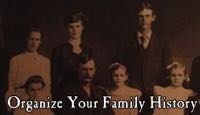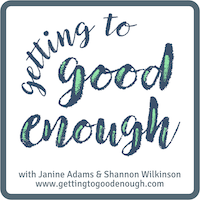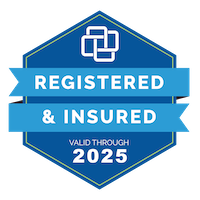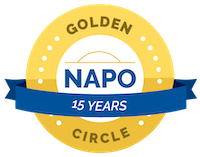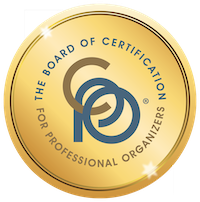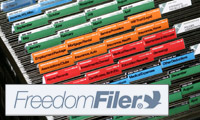Mynd makes your iPhone calendar better
I’m an Apple fangirl. As I’ve written here many times, I love love love my iPhone. (I currently have a 5s). I also love using an electronic calendar. I’ve been using iCal for my calendar ever since I got my first Mac in 2008. (Before that, I used a Palm Pilot.)
I use iCal on my MacBook. (I’m currently using version that came with the OS X Lion but am planning to get a new MacBook Pro with Mavericks in the next month or so.) I was perfectly satisfied with the built-in calendar app on my iPhone and the way synched with my computer and iPad. I saw no reason to change anything.
And then my friend, Shannon, told me about Mynd. When she emailed me about it, she wrote, “I never got the point of using a calendar app besides the native one until I tried this. It’s fantastic!” As usual, Shannon is right.
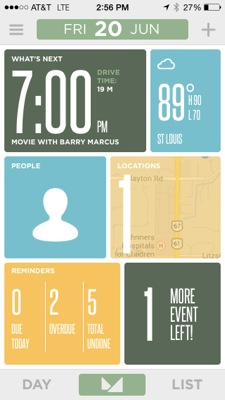
Mynd is an advanced calendar app. I think of it as an overlay over iCal. It takes the information I enter on my MacBook, iPad, or iPhone (whether I enter it in Mynd or with the native calendar app) and makes it smarter and more beautiful.
When I enter an appointment on my calendar and include the location, Mynd monitors the traffic between me and the location appointment and lets me know how long it’s going to take to get there. It sends me a notification when it’s time to leave and it points out when I’m running late. As a punctuality-challenged person, I find this hugely helpful.
In addition, Mynd tells me the temperature where I am and where I’m going. It tells me what people I’m going to be seeing today (including their Linked In photo), it lists the number of reminders I’ve set for the day (and how many are overdue) and it provides a map of the location I’m going. All that is on the one beautifully tiled screen
Mynd allows me to attach Evernote notes to a meeting appointment. It pulls up the Linked In profiles of the meeting attendees and it allows me to schedule meetings from the app—reserving the time slots I’ve offered as meeting time possibilities until the meeting is actually scheduled. I’m sure it has other features I haven’t even explored yet.
Mynd is available for iOS only. You can use it with iCal, Google Calendar or whatever calendar you’re synching to iOS. It’s free and easy to set up. You can download Mynd on iTunes. For more details, check out the Mynd video or this TechHive review.
How Fitbit is keeping me active
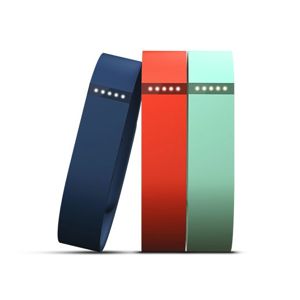
I’m a natural-born couch potato and I struggle with getting myself to get adequate exercise. I’m not someone who craves it or enjoys it, but I do appreciate that it’s important.
Last month, I took Shannon Wilkinson’s Change Artistry: Get Active group coaching program and it was hugely helpful in changing my mindset about exercise. It now feels much less like drudgery and I’m feeling very good about the exercise I’m getting.
One of the things Shannon helped me with was getting in touch with why exercise is important to me. Now that I’m over 50, I’m concerned about aging. I want to stay healthy and active for many more decades and I know that exercise now will contribute to that.
The other thing that Shannon has helped me understand about myself over the years is how important it is to to me to meet my commitments. (In the parlance of Gretchen Rubin, I’m an Upholder.) By the end of the Change Artistry class, I’d identified two very specific, measurable goals for my exercise. (And that’s where the Fitbit comes in.)
They are:
- Go to the gym three times a week
- Walk 10,000 steps a day at least three days a week
I’ve made a spreadsheet to keep track of it. I’ve been keeping my commitment to get that level of exercise and it feels great.
I don’t think I’d be where I am without Shannon’s program, but I also think my Fitbit Flex is playing a large role. Because my work is sometimes (but not always) quite active I think I overestimated my level of activity. I wear my Fitbit wristband all the time (except when I take it off to charge it every five days or so) and I was a little surprised to learn that without making extra effort I would get 6,000 to 7,000 steps in during an average day. 10,000 steps is the goal most folks have.
The Fitbit allows me to monitor how well I’m doing toward my goal of 10k steps. And it gives me incentive to walk a little more, if need be, to reach my goal. I’m now taking the steps, rather than the elevator. I’m coming along on evening dog walks. (I do the morning poodle stroll, my husband does the evening.) I’m seeing exercise as an opportunity to fulfill my goal, rather than just something that just tuckers me out.
The Fitbit Flex also measures my sleep quality and allows me to log calories and water consumption. I haven’t taken full advantage of the latter, but it is making me more mindful of what goes into my body (both food and water).
There’s a social component to Fitbit that doesn’t particularly appeal to me, but I could see how one easily set up a Fitbit accountability group (or a group competition).
The Fitbit is helping me keep fitness and activity top of mind. I know that in reality it’s not much more than a fancy pedometer, but after less than two months owning it, I think I’ve benefitted enough to merit the $100 expenditure. I’m now pondering buying the Fitbit Aria wifi scale, which would upload my weight to my Fitbit dashboard. That seems a bit excessive, since weight loss isn’t really part of my goal, but I am intrigued.
If Change Artistry: Get Active appeals to you, you’ll have to wait until the fall to take it again. But if you have a project you’ve been wanting to do but can’t seem to get around to it, check out Shannon’s Change Artistry: Get Started. It starts this Thursday and it will be equally great.
Improving my jewelry storage
I don’t have a ton of jewelry, but I have my share. I wear earrings virtually day and on some days I also wear necklaces or bracelets. As a result, how well my jewelry is organized really has an impact on my daily life.
For years, I’ve limped along in this regard. I’ve tried lots of different jewelry boxes and sometimes had several different jewelry boxes littering the top of my dresser.
Most recently (probably two years ago), I came up on this solution, which worked pretty well for awhile.
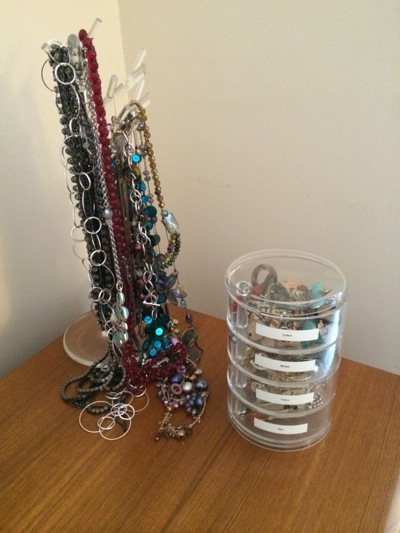
I kept my earrings in the little four-section swivel organizer. I divided them into three categories that worked for me (colored, metal, dressy) and used the bottom section for brooches. I kept necklaces on a tree-themed jewelry stand.
That still left bracelets to be stored and they sat on the bureau in this little inappropriate tray. (The cream-colored box contains my grandmother’s pearls.)
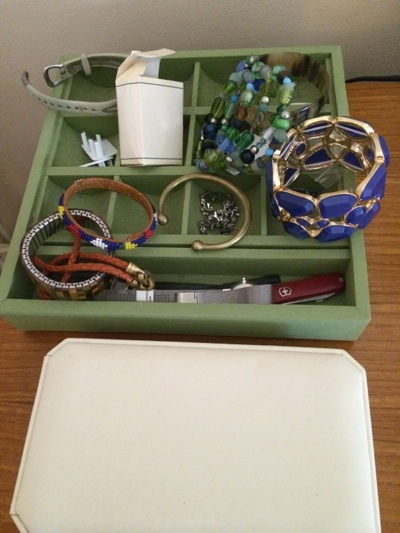
It worked for awhile, but usability issues soon formed. I found I had trouble finding the earrings I wanted, especially in the morning when my husband was still sleeping. He’s a light sleeper and I knew that my pushing around the earrings trying to find mates was disturbing him. I also usually had trouble finding the necklace I was looking for.
I’m delighted to report that I’ve a solution that I think is going to work really well this time. I purchased three jewelry stacker boxes at the Container Store, after seeing them at a client’s house.
In the top section, I keep the earrings I wear most often, plus the brooches (which I actually don’t wear very often).
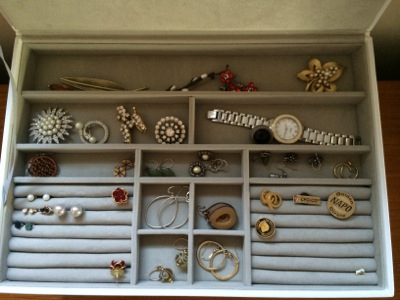
In the tray beneath that are earrings.
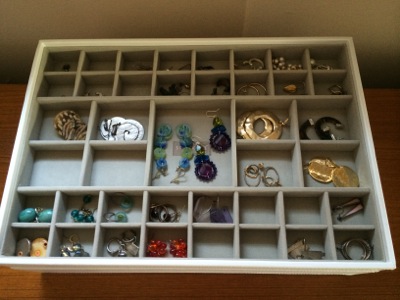
And in the bottom, deep section are bracelets and watches.
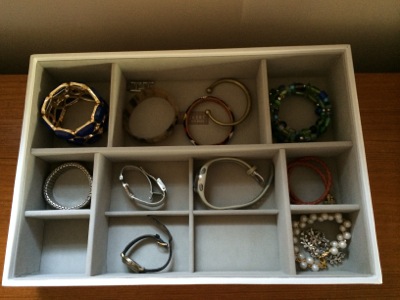
For the necklaces, I mounted this tie rack on the wall next to the bureau. Now the necklaces are separated (one per peg), so I can easily find them.
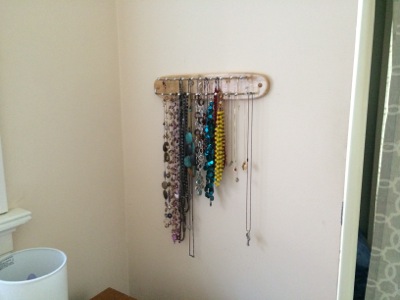
Before this month’s jewelry reorganization, this is how my bureau looked on a good day (this is an after picture from a post on decluttering my bureau top):

This morning, I took this photo. (I moved my grandmother’s pearls, which I rarely wear, as well as the little plastic containers of shoe- and clothing-related accessories, inside the bureau.) I’ve literally never had such a clear bureau top, and this makes me very happy!

Got a project you need help starting?
Do you have an idea for a project or activity that would make you happy? Have you been dragging your feet on getting started? If so, I have great news for you!
My friend, life coach extraordinaire Shannon Wilkinson is offering the second installment in her new Change Artistry series of group coaching classes. This one is Change Artistry: Get Started. It’s a four-week class that will help you let go of any barriers you have to getting started on the thing you want to do.
I just finished Shannon’s Change Artistry: Get Active four-week coaching program. (I blogged about how excited I was about it, before it began.) It was fantastic. Shannon’s tools feel a little bit like magic, they’re so effective. During her class, I was able to shift my perspective on getting more exercise, turning it from drudgery into something I do as a favor to myself. I’ve improved my activity level and, more important, I’ve improved how I feel about exercising.
I know her Change Artistry: Get Started class is going to be equally effective. I’ve already signed up for it.
So what is it you’ve been wanting to do? Here’s your chance to stop procrastinating and get started on it—and have fun doing it.
The four-week class is $200 if you sign up by noon Pacific time on April 13 (that’s this Friday!). After that, it’s $250. Sign up here!
RIP Springpad
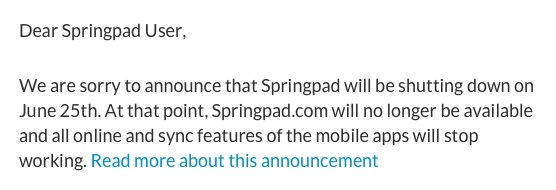
I was so excited at the beginning of this year to partner with Springpad, the digital organizing assistant, to create some custom Springpad notebooks. When they first approached me in November 2013, I started trying out the service to see if it was something I wanted to be involved with. From the beginning, I loved it. It was the first electronic task management system that ever worked for me.
Just over a week ago, I learned the sad news that Springpad is ceasing to exist as of June 25.
What a blow. The good news is that Springpad has created some export tools to ensure that no one’s data will be lost, as long as you do the export before June 25.
So now I have to find an alternative to Springpad. Springpad’s biggest competitor has been Evernote. And, sure enough, one of the export tools allows for all Springpad data to be transferred to Evernote, which is handy.
The trouble for me is that I’ve tried unsuccessfully several times over the years to use Evernote. The interface just doesn’t seem to work as well for me. I’m giving it another try now. I purchased the ebook Evernote Essentials by Brett Kelly to help me. Now that I know the value of an online repository like this, I think I’ll try harder to make it work for me. (There’s also a Springpad community discussion on alternatives to Springpad that I plan to explore.)
Another challenge is that Evernote is not great for task management, something Springpad excelled in (for me, anyway). So I’ve been researching other electronic task management options. Right now I’m experimenting with TeuxDeux on the web and iPhone app. I like it. It’s a bit more like using paper than other systems I’ve tried. And it’s very attractive, to my eye.
Free services are great. Who doesn’t like free? But sometimes, as in the case with Springpad, free just isn’t sustainable. I’d have gladly paid a monthly fee for Springpad. I’m going to remember this as I seek alternatives. Free may not be the best choice.
To work or not to work on airplanes?
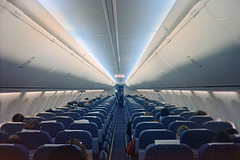
I’m at the end of a week-long trip and this morning I get on an airplane. This has been a fairly leisurely trip, not too work intensive, and I’m pretty mellow and relaxed. But on Monday, I’ll have to hit the ground running.
So the question is, do I try to focus on work while I’m traveling and play a little catch up? Or do I take it easy, enjoy my novel and carry on the mellow feeling until Monday. (I’m traveling this morning to Ohio for a family bar mitzvah, so I don’t get back to real life until Sunday night.)
Ordinarily, I think I’d write out a to-do list and see how much I could get done, especially since I personally find airplanes a great place to concentrate.
But last week, I read an interview on Lifehacker with Evernote CEO Phil Lubin and I took note of this statement:
I don’t work on airplanes. I sleep, I play Minecraft, I read (non-work stuff), I watch movies, I daydream. I don’t work. It’s great. Makes me look forward to that 13 hour flight to Japan!
I found that pretty inspirational. Lubin goes on to say, “Sure, I lose some productivity on airplanes, but getting rid of all the pre-flight dread more than makes up for it.”
I’m not sure I have pre-flight dread, but I do get a little caught up in making sure I have everything with me to get done what I feel I need to do. If I let go of that and just pull out my Kindle and enjoy a book, my trip might become less stressful and more enjoyable. I’ll have my iPad, so I can take some notes if I’m inspired. And on this particular trip, I have a four-hour layover, so perhaps I’ll consider doing some work then. Or not.
I think the notion of having an “I don’t work on airplanes” mentality fits right into my “Let it be easy” mindset.
What about you? Do you work on airplanes or take it easy?
Photo by Julian Eilert via Flickr.
Making travel mornings smoother
This morning, I had a flight that departed at 5:50, which meant I needed to leave for the airport at 4:15. That meant I needed to get up at 3:15. In the morning. Actually, I probably should have either (a) arised earlier or (b) packed absolutely everything but morning essentials the night before.
I was rushed getting ready. And I was a bit groggy. As a result, I forgot to pack a few things. Nothing critical, but I’m still kicking myself. (I forgot my backup battery charger for my iPhone or iPad, my car charger for my phone—which I may not need if my rental car has a USB port—and toothpaste and mascara.)
The thing is, I’m not a haphazard packer. But I find it’s the stuff I pack on travel day that can problematic.
I had a little time at the gate, and as I sat there thinking about the things I’d forgotten to pack, I created a checklist of items to consult on future trips. I put an asterisk next to the ones I forgot this time, hoping to reinforce remembering them in the future.
Since I tend to take morning flights, I think I’ll take it a step further and create a list of things to pack the night before and things to pack in the morning. Obviously, the more I pack the night before, the better. My practice has been to pack electronics in the morning.
Another helpful thing I could do would be to have travel versions of most of my toiletries, which reside in my travel toiletries kit. Then I wouldn’t have to worry about packing those items. I already do that for a lot of things, like shampoo and conditioner, but I’d run out of travel-sized toothpaste.
I dislike being rushed or frazzled (I literally was repeating that Phil Dunphy maxim, Slow is smooth and smooth is fast, as I was getting ready this morning.) I think these checklists will make my next trip easier.
Search
Recent Posts
- Budgeting and decluttering: It's all about priorities
- Today's truth bomb
- Worth repeating: Labels in the refrigerator
- The meat of my Bullet Journal
- Worth repeating (again): Getting past "I might need it some day"
- Furthering your goals one tiny step at a time
- Repeating spreads in my Bullet Journal
Tags
Links
- Are you interested in becoming a professional organizer?
- Ravelry
- NAPO St. Louis
- Shannon Wilkinson, life coach
- Organize Your Family History
- National Association of Productivity and Organizing Professionals
- Getting to Good Enough podcast
- Peace of Mind Spending
- Institute for Challenging Disorganization


